12 Best Things to Do in Permet: Permet Albania Travel Guide
16 min readFind all the best things to do in Permet, a hidden gem in Albania, in this comprehensive Permet travel guide.
Away from the buzz of the Riviera and the popular UNESCO cities of Gjirokaster and Berat, southeastern Albania is still very much an under-the-radar destination.
I fell in love with the city of Korca on my first trip back in 2019. So when it came time to return to Albania, I knew I had to explore more of the interior regions that run along the Greek border.
Permet (Përmet) is a small city on the new road between Gjirokaster and Korce. It is an ideal inclusion on any Albania road trip that travels from the coast to Lake Ohrid.
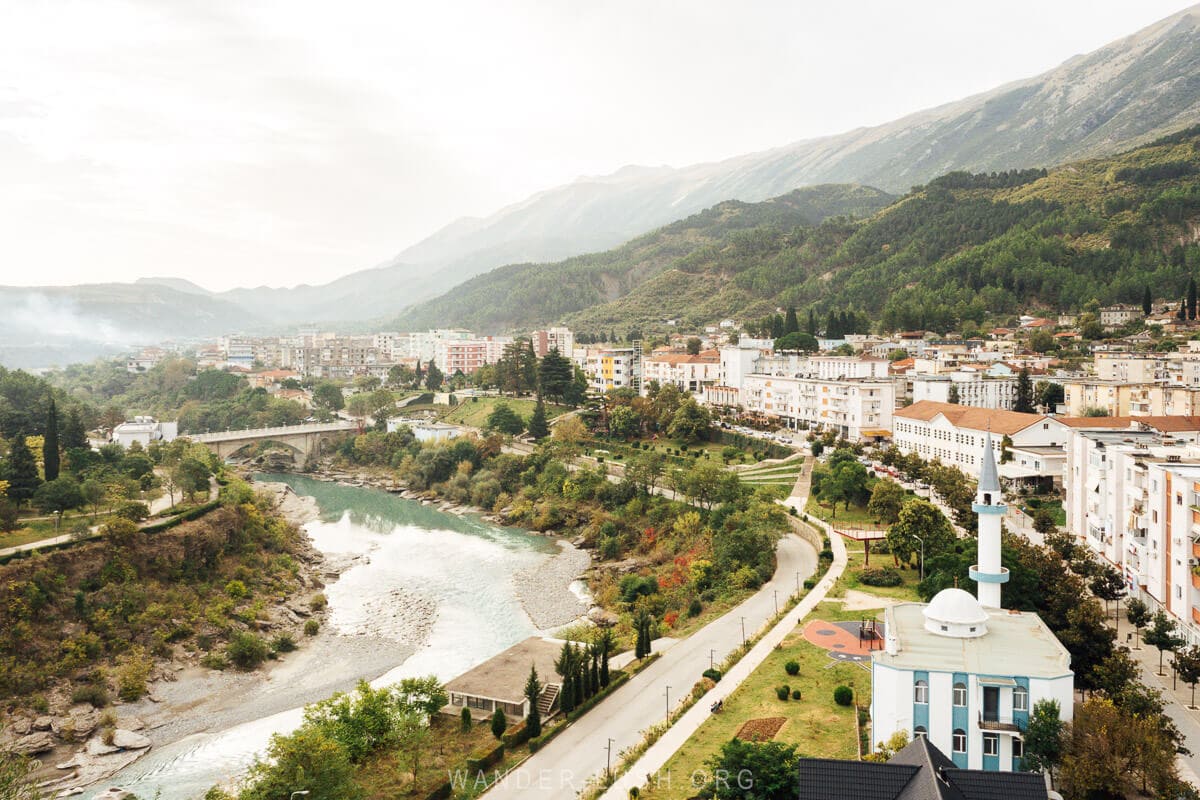
Located on the Vjosa River (sometimes referred to by its Greek name, Aoos) at the periphery of Fir of Hotova-Dangëlli National Park, Permet is known as Albania’s ‘greenest city’. It is the gateway to Europe’s last wild river and an emerging ecotourism destination that I predict will become big in the years to come.
On top of that, Permet is a Slow Food hotspot known for its regional cuisine and excellent restaurants. Its unique mix of socialist architecture, cute Old City and antique shops are a photographer’s delight.
On the outskirts of the city, you will find the spectacular Orthodox Church of Leus – which I believe is the most beautiful church in Albania – as well as the famous Benja Thermal Springs and lesser known Sarandaporo Thermal Springs.
This Permet travel guide covers it all, along with my tips for planning your visit.
Please note: This post contains affiliate links, meaning I may earn a commission if you make a purchase by clicking a link (at no extra cost to you). Learn more.
When to visit Permet
Permet is a year-round destination. Late spring and early summer are the best times of year for watersports on the Vjosa, while the autumn months (from late October) bring beautiful fall colours. Summer is good for hiking, but it does get hot in July and August (highs in the mid-30s celsius).
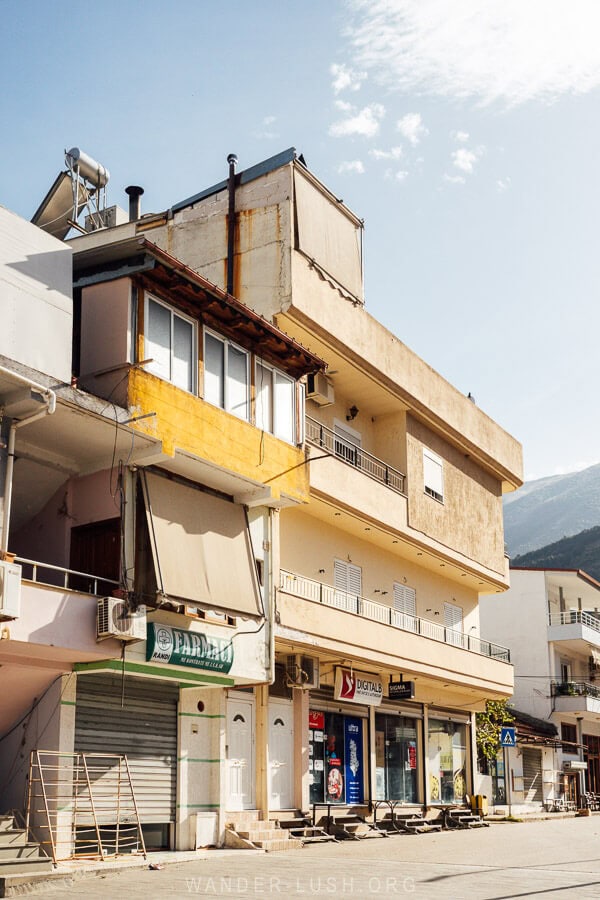

Winters are relatively mild (lows of 10 celsius in January), but snow is common. Permet and Korce are both popular winter destinations in Albania, so you will find things are open throughout the off-season.
We visited Permet in the middle of October. The colours were beautiful (though a few weeks off from full array), the temperatures were pleasant, and it was not too crowded at all (aside from the Benja Thermal Baths, which are always busy at certain times of day).
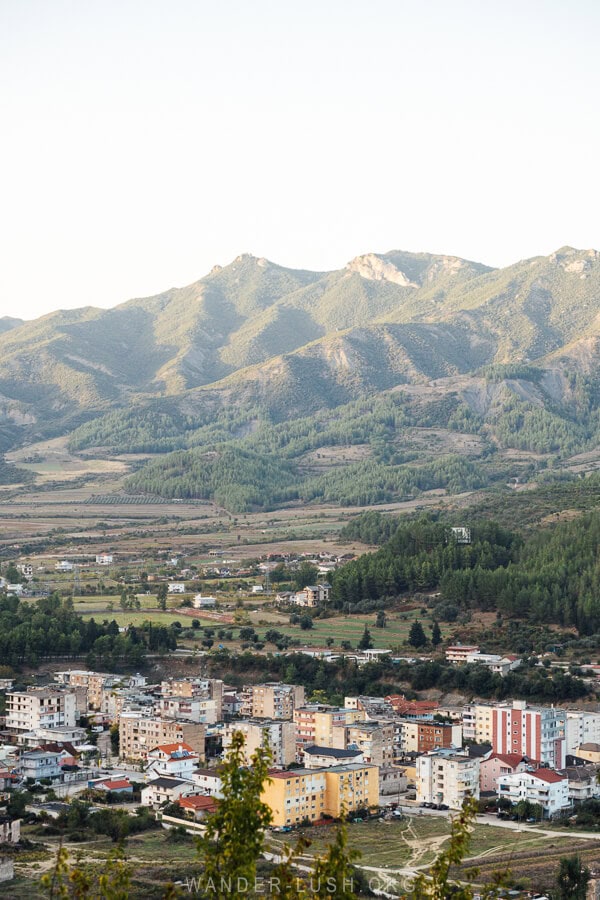
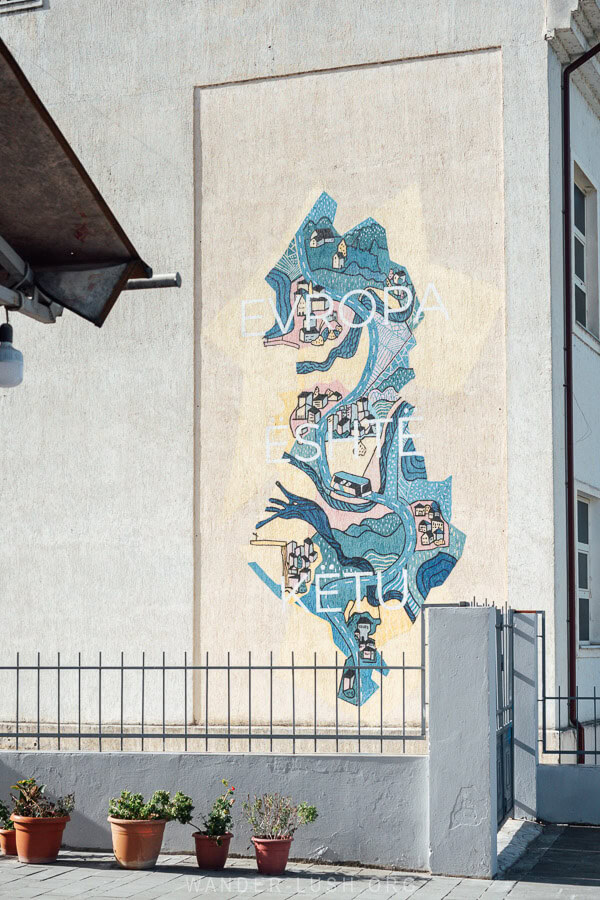
How to get to Permet
Permet is located 240 kilometres (approximately 4-4.5 hours) from Tirana. Whether you are self-driving or using buses to get around, I recommend breaking up the journey in Gjirokaster or Berat, which are both more or less enroute.
Alternatively, you can approach Permet from the east via Korca.
By car
In Albania, I recommend hiring a car from a local agent via Local Rent. Prices are competitive, and most vehicles do not require a cash deposit or a credit card. I used Local Rent on my road trip and couldn’t have been happier with the service.
From Gjirokaster: This 62-kilometre road arcs around Zagoria Nature Park, taking around 1.5 hours to reach Permet. The road is in perfect condition (suitable for a sedan), and there are lots of points of interest to see along the way.
I highly recommend a short detour to Tepelena (famously the birthplace of Ali Pasha) for the castle and nearby Ali Pasha Aqueduct.
From Korca: This 130-kilometre road traces the Greek border and passes through lovely little Leskovic. For part of the drive, you are following the spectacular Vjosa River. The road is newly sealed and in great condition (suitable for a sedan) save for a few rough patches that are probably fixed by now. Allow a minimum of 3 hours.
Be sure to make photo stops at the Vjosa River Bend and at this abandoned wooden bridge.
From Berat: There is a 100-kilometre inland ‘shortcut’ between Berat and Permet via Osumi Canyon, Tomorri Mountain National Park, and Albania’s wine region. I travelled on this road back in 2019 – it was in good condition then. Travel time is around 4 hours.
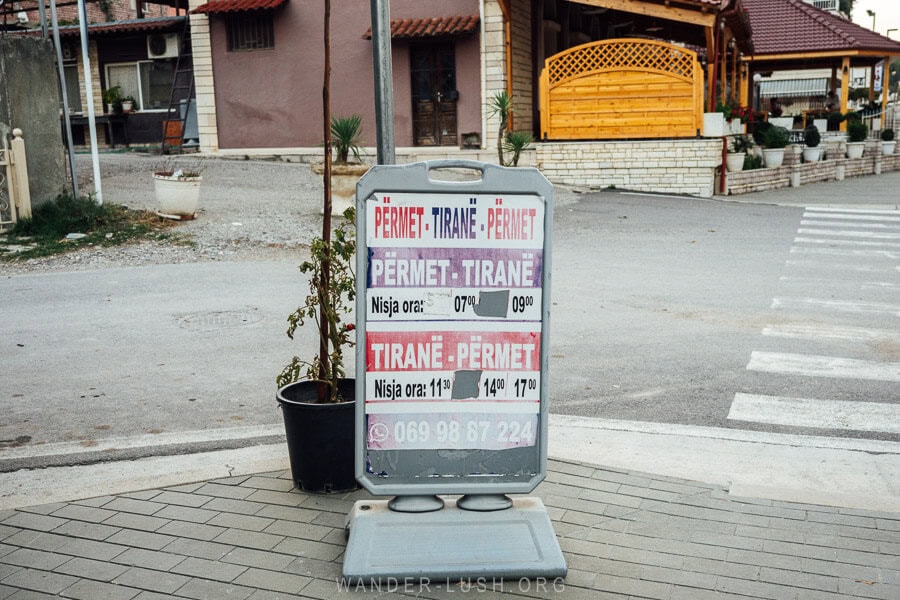
By bus
If you don’t have a car, Permet is easy to reach by public bus. Both coaches and furgon minivans operate on this route.
- From Tirana (East Terminal): 15+ direct vans per day; 4.5 hours travel time; ~1,200 lek
- From Berat: 1 direct van per day; 3 hours travel time; ~700 lek
- From Korce: 3 direct vans per day; 3.5 hours travel time; ~800 lek
- From Vlora (via Tepelena): 12+ direct vans per day; 2 hours travel time; ~600 lek
Permet Bus Station is in the centre of the city – see the exact location here.
Check bus times and reserve tickets online for some routes using the Gjirafa Travel website.
Where to stay in Permet
Villa Permet
We treated ourselves to a couple of nights at the elegant Villa Permet, and it was totally worth the price tag. Staff were friendly and helpful (they even gave us a free upgrade), and our room was tastefully decorated and spacious.
Breakfast on the terrace was great. The only thing I didn’t like about this hotel was the one-cup limit on coffee. Boo!
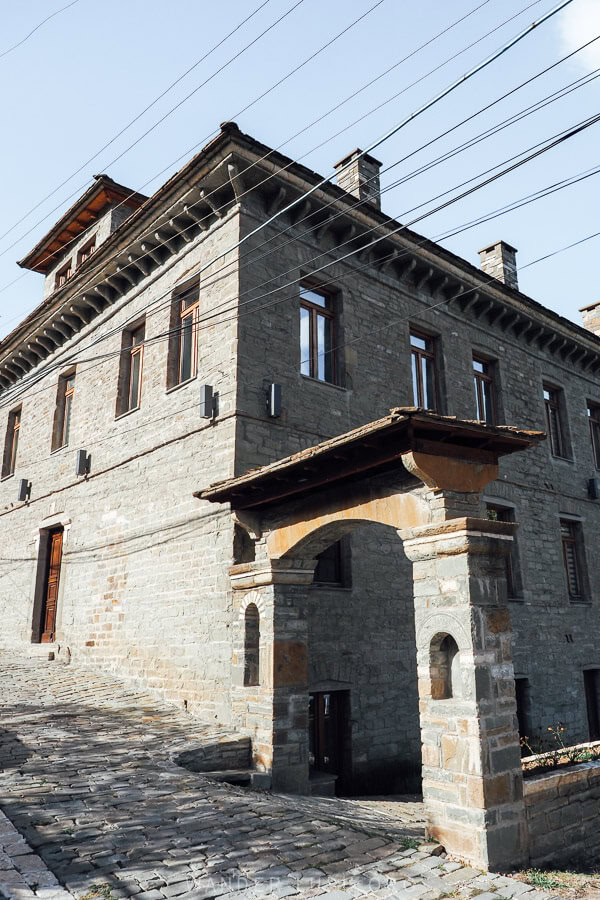
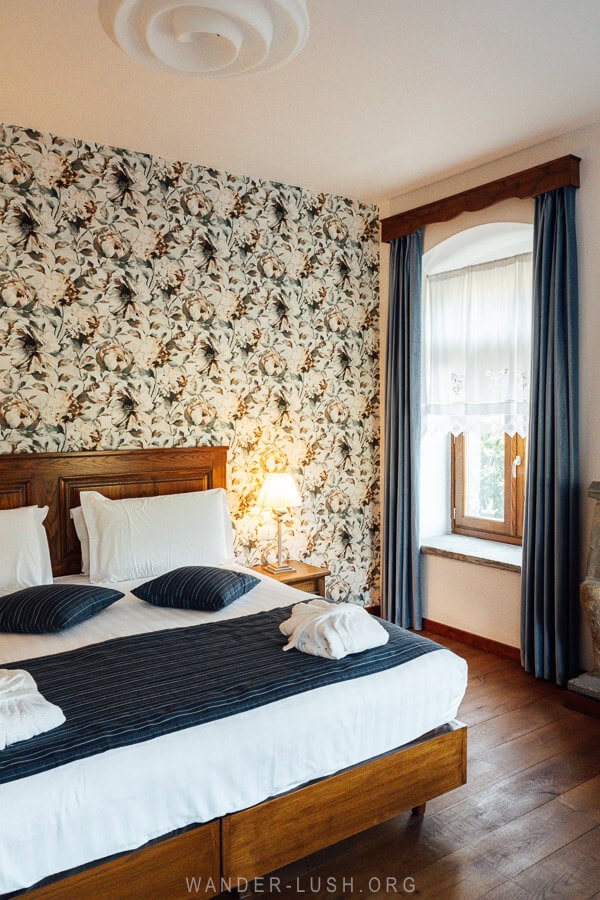
GuestHouse Shtëpia ime
We extended our stay in Permet (that’s how much we loved it) and chose this family-run guesthouse for our extra night. Our room at Shtëpia ime was modern and comfortable. The owners were very friendly.
Chri Chri Guest House (Leus)
We didn’t get to stay at Chri Chri in Leus (unfortunately it was booked up), but you had better believe that I will be going back to Permet just to stay here. The guesthouse is located on the hill above the city in the charming village of Leus (more below). The rough road requires a 4WD, or else the owner can pick you up from Permet on request.
Map of Permet
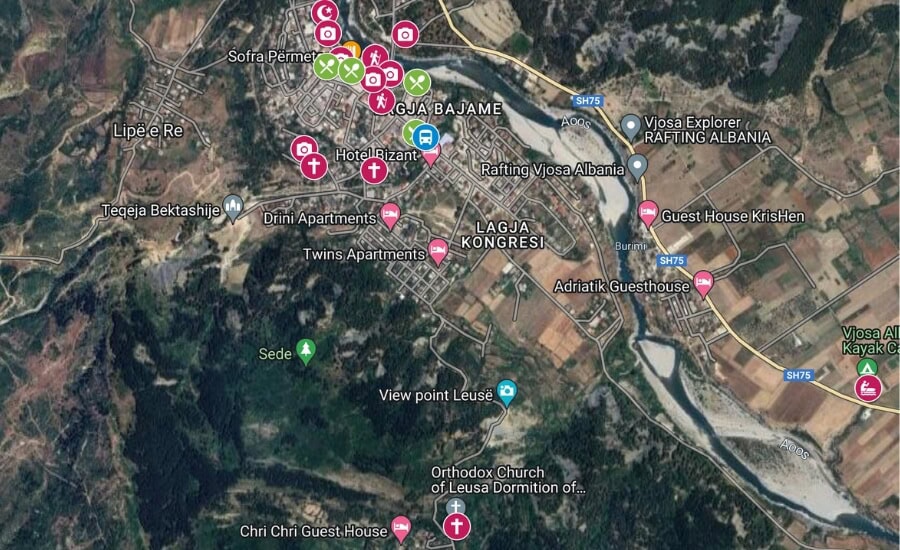
Things to do in Permet
If your schedule allows it, I recommend basing yourself in Permet for 2-3 days. The city centre is walkable. It is easiest to get around with your own car, but public buses and taxis are readily available too.
1. Savour Permet’s Slow Food scene
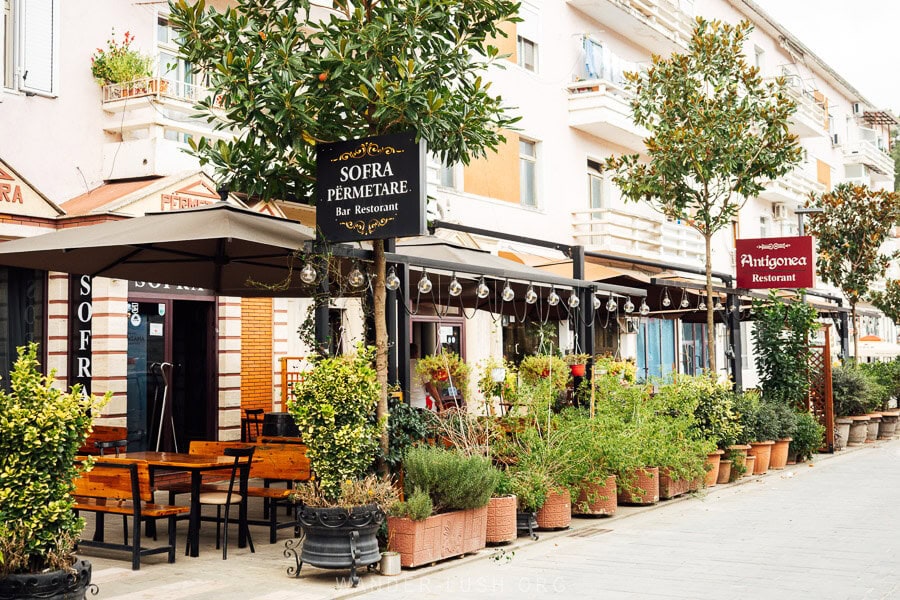
Permet is a somewhat unlikely bright spot in Albania’s foodie scene. Personally, I am a big fan of Albanian food – after travelling the Balkans for six months straight, I found it to be one of the most diverse, flavoursome cuisines in the region. But I certainly wasn’t expecting such a small city in such a randomlocation to be a foodie mecca.
For background, the Slow Food Movement is very popular in Albania, with farm-to-table restaurants such as Mullixhiu in Tirana and Fustanella Farm (the latter is absolutely a must visit!) gaining a huge following in recent years.
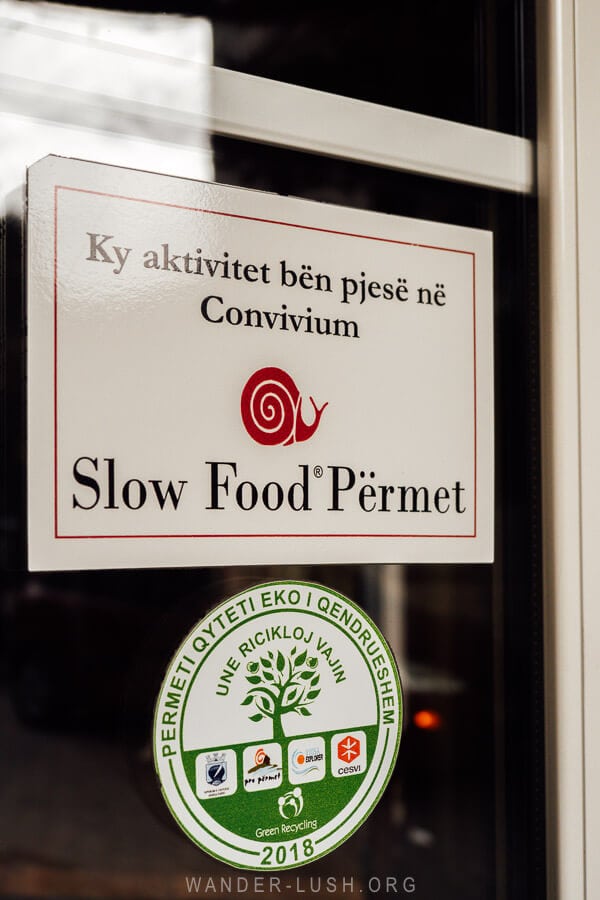

Permet has half a dozen or more restaurants that adhere to the Slow Food philosophy, focusing on local produce and recipes that preserve the area’s culinary traditions. This includes rich soups, flaky pies, and sweet gliko walnut, fig and plum preserves.
If you only have time for one meal in Permet, I recommend eating at Trifilia. This restaurant highlights organic produce and has a number of Permet specialty dishes on the menu. The setting is lovely, especially the back veranda.
We had the wild greens with olive oil and lemon, and the mesnik pie with veal and spring onions. The highlight was definitely the pule fshati me therrime – AKA drudhe, a traditional Permet chicken soup thickened with a crumbled flour-and-egg-yolk dough. The soup is butter-rich, lemon-bright, and has a unique texture.
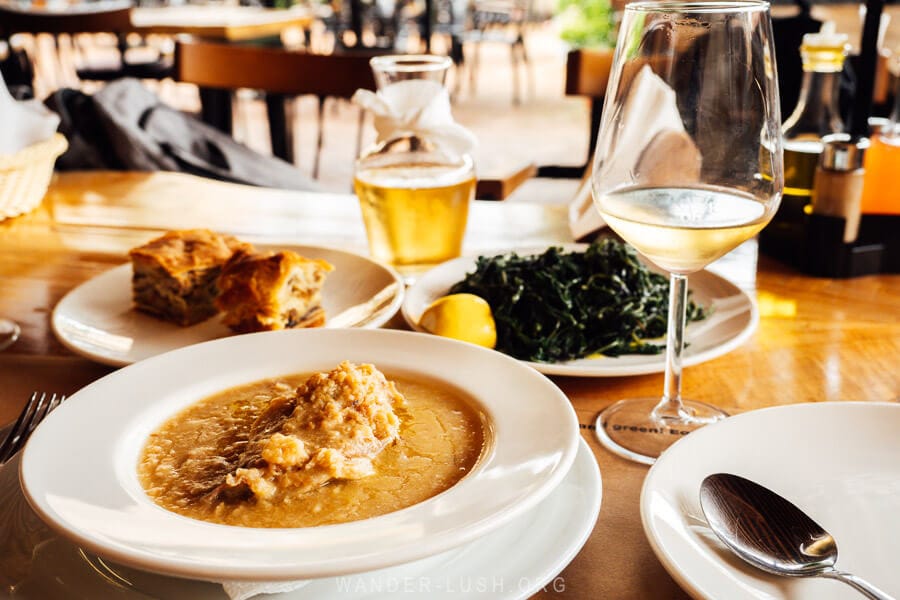
Our first meal in Permet was at Sofra Përmetare on the main street. Shqeto permetare – a creamy soup made with fatty lamb, traditionally served at weddings and funerals – is the thing to order here. We also enjoyed the stuffed aubergines.

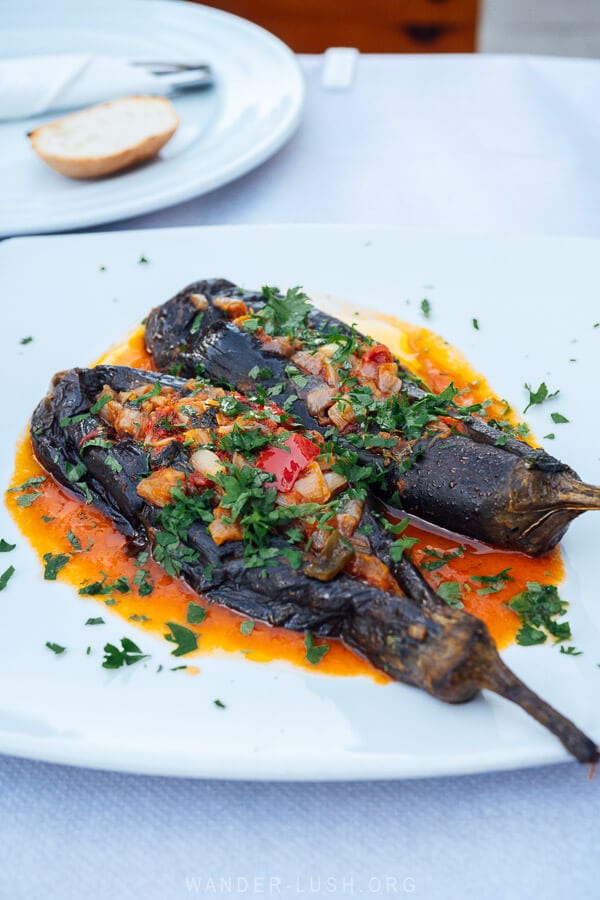
Te Culi Slow Food Dishes has a nice location down on the river. Both of the soups mentioned above are served, but we opted for one of the casseroles – a spiced moussaka made with pumpkin. The house wine here was the best we had – 100 lek for a generous pour.
Finally, we ate a late dinner at Restorant Familjari in the city centre. The terrace overlooking one of Permet’s main streets is lovely in the evening, and the indoor dining room is a bit extra. It feels more like a banquet hall than an intimate restaurant, but the food here really delivered. Our favourite dish was the meatballs.
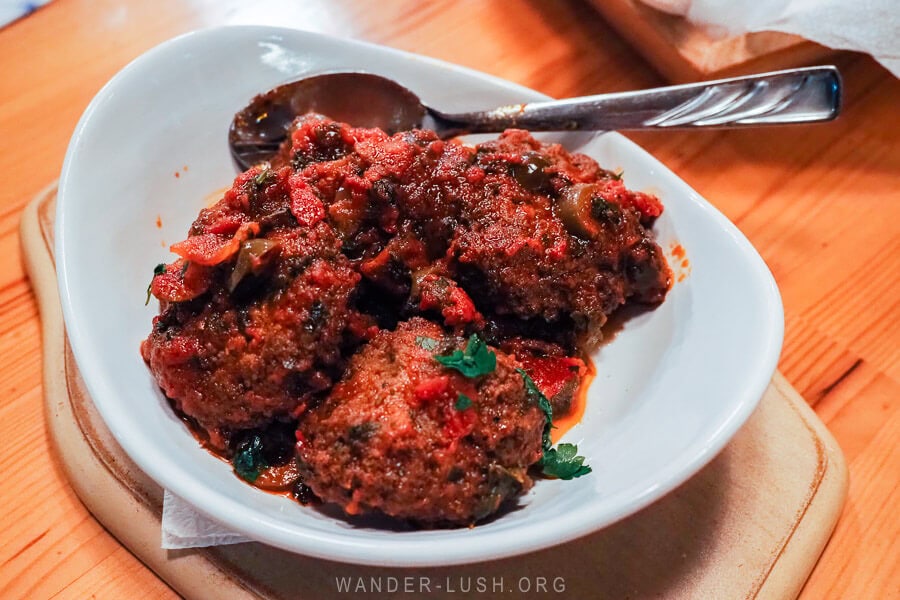
I also had Restaurant Velia saved to my list, but we didn’t make it this time. Restorant Antigonea next door to Sofra is also highly regarded. There is a restaurant at Villa Permet, but since we had breakfast here each morning, we decided we didn’t need to try the lunch/dinner service.
2. Hike to the Orthodox Church of Leus
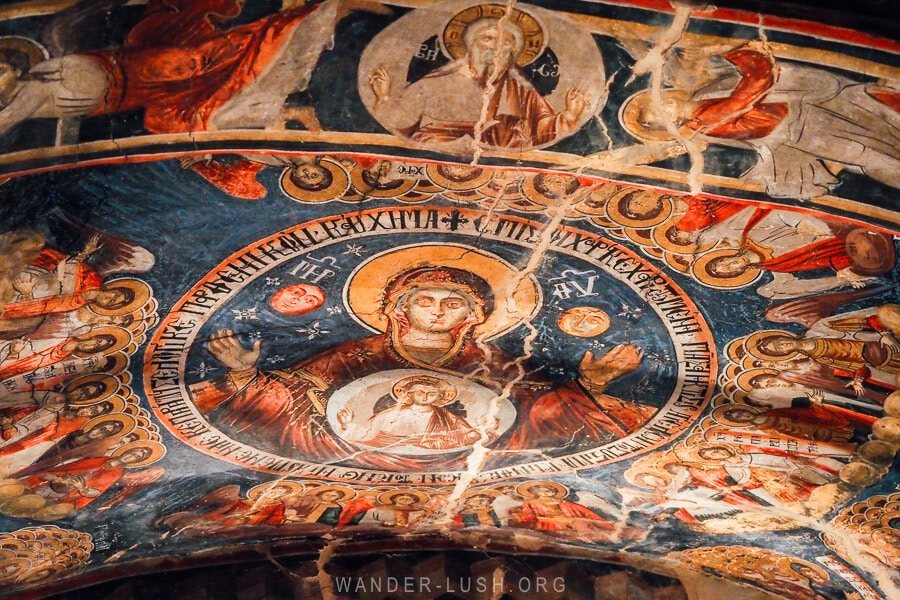
Leus (Leusë) is a small village located 2 kilometres outside of Permet, walking distance from the centre of the city. A real slice of rural Albania, it is all riverstone alleys, haystacks and charming houses.
The number one reason to visit Leus is to see the village’s post-Byzantine Orthodox church, St. Mary’s. Covered from head to foot in frescoes, it remains the single most impressive church I have laid eyes on in my life. It’s hard for me to put into words just how mesmerising it is.
It takes 60 minutes at most to walk up to the church via a steep, unpaved road. It is possible to get a 4WD taxi, but for excellent views of Permet on the way up, I do recommend going by foot.
For full details (and lots more photos!), see my quick guide to visiting the Church of Leus.
3. Soak in the Benja Thermal Springs
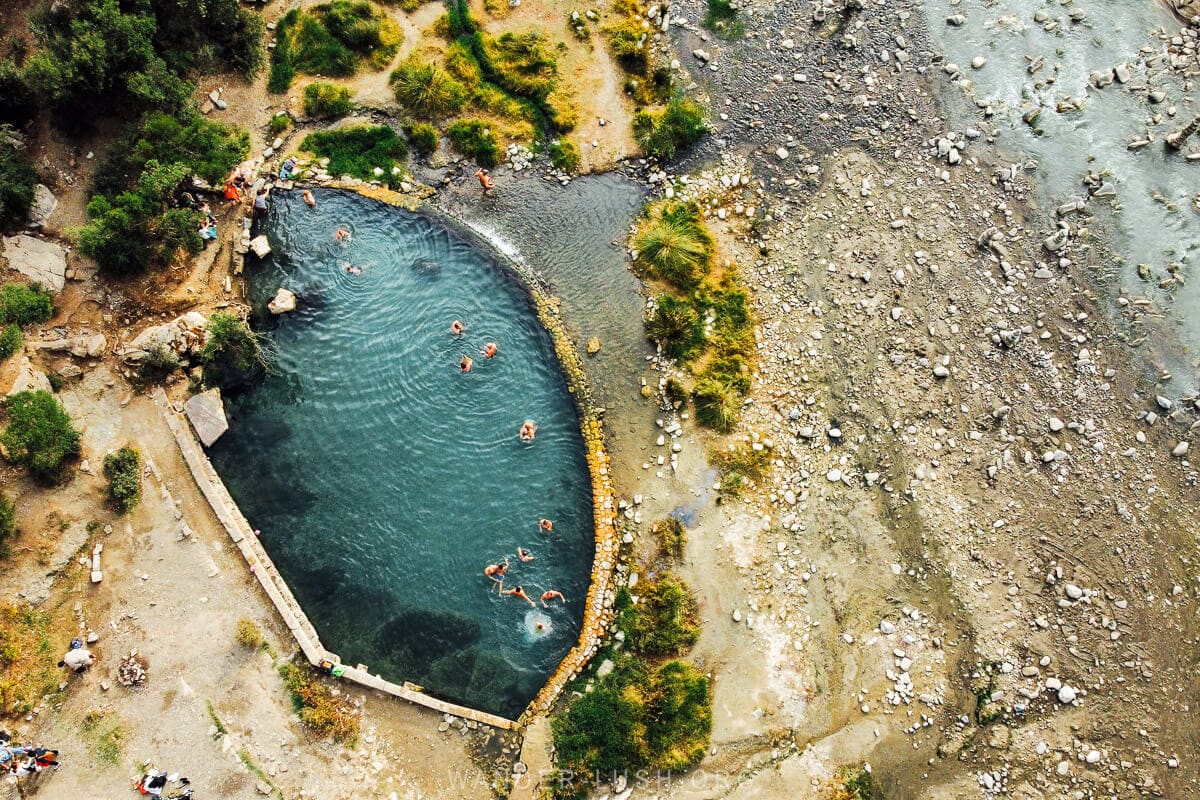
Located 14 kilometres outside of the city, the Benja Thermal Springs (Llixhat e Bënjës) are located inside the spectacular Fir of Hotova-Dangëlli National Park.
The 5-kilometre-long Lengarica Canyon opens up on the edge of the park. Its soaring rock walls – 150 metres high in some places – conceal deep caves and other treasures. It reminded me a bit of an Omani wadi, only the river that runs through the canyon is very wide.
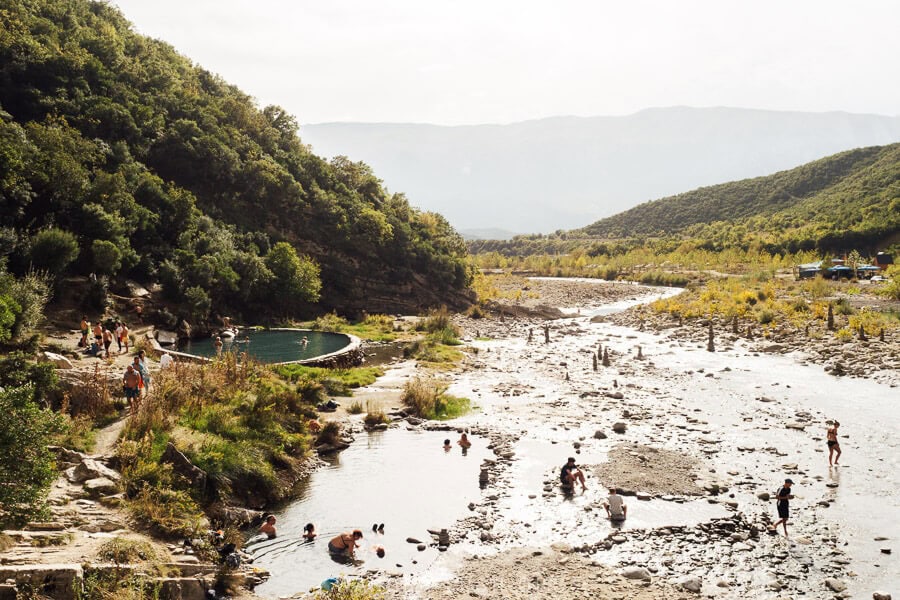
Six chloro-sodium-calcium springs lurk below the riverbed and push thermal waters to the surface. A set of round and tear-shaped pools have been cast from stone and cement, each one topped up with naturally flowing waters of a different mineral composition and temperature, ranging from 22-28 celsius.
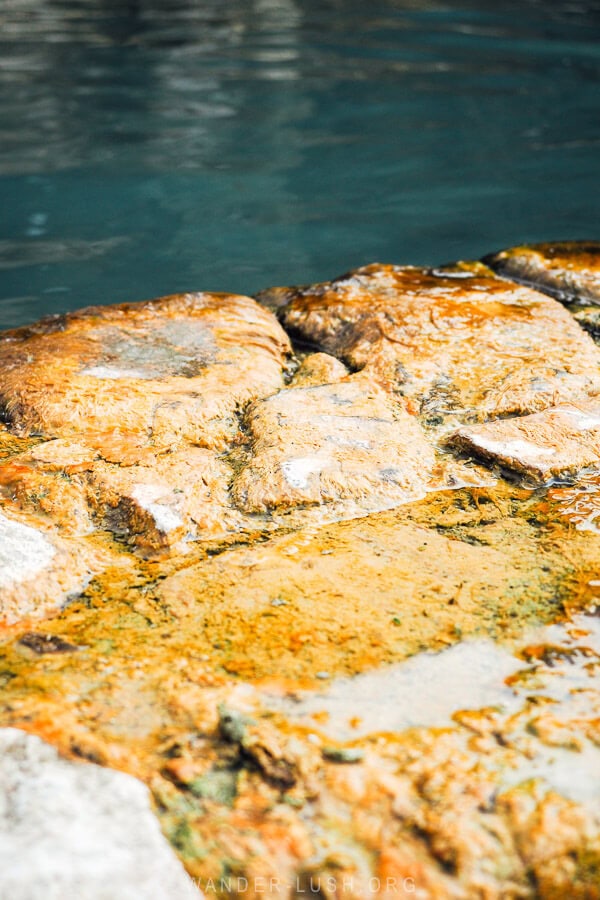
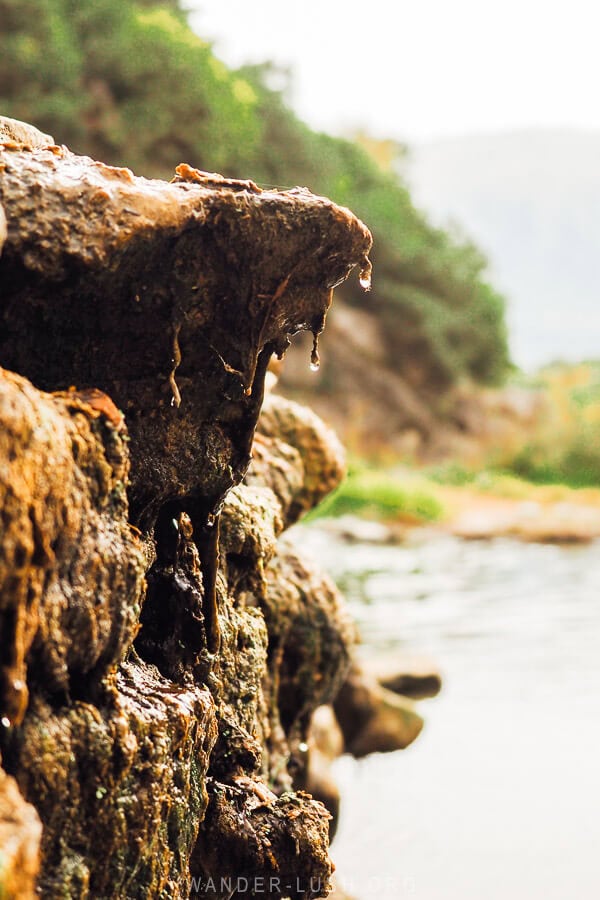
Coming from Georgia – the land of mineral springs – I am very well acquainted with this sort of open-air remedial spa. Benja’s setting is exceptionally beautiful: The rugged canyon, the brilliant foliage, the rocky riverbed dotted with stone cairns and of course the gracefully arched Ura e Kadiut – an Ottoman-style bridge from the 1700s that bends over the river – all combine to create a truly magical scene.
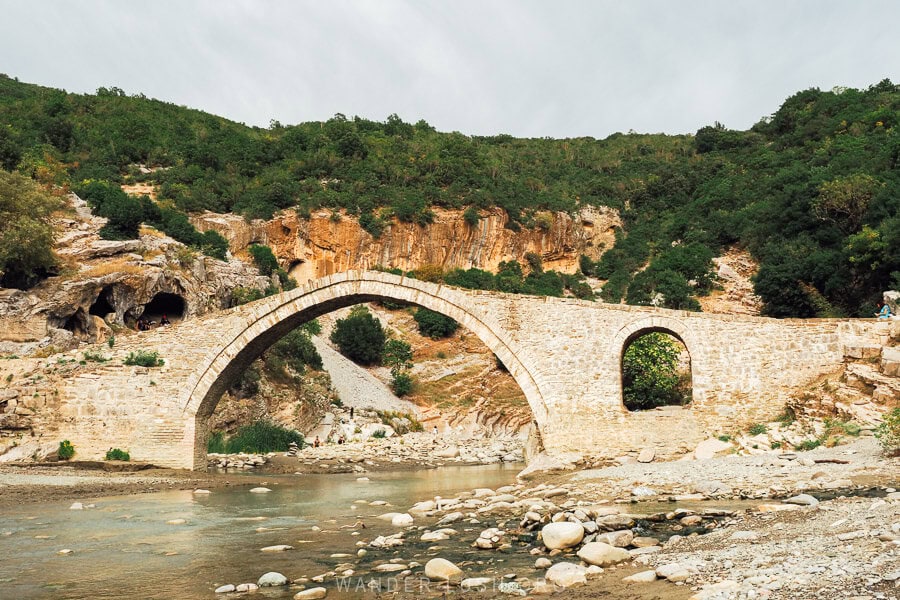
We arrived at the springs in the early afternoon and it got progressively busier as the day went on. The site is open 24-7 so for a bit of peace and quiet, I recommend going early. You should avoid the area after heavy rain, though, as the rocks become very slippery and the water level in the canyon can rise rapidly without warning.
It is possible to drive all the way up to the old bridge via an unsealed road. We managed just fine in our little sedan. From the car park, you can already smell the sulfur aroma rising off the baths.
The first pools sit below the bridge’s abutments and are easily accessible from the parking area. To venture further into the canyon, you will need waterproof shoes and proper gear.
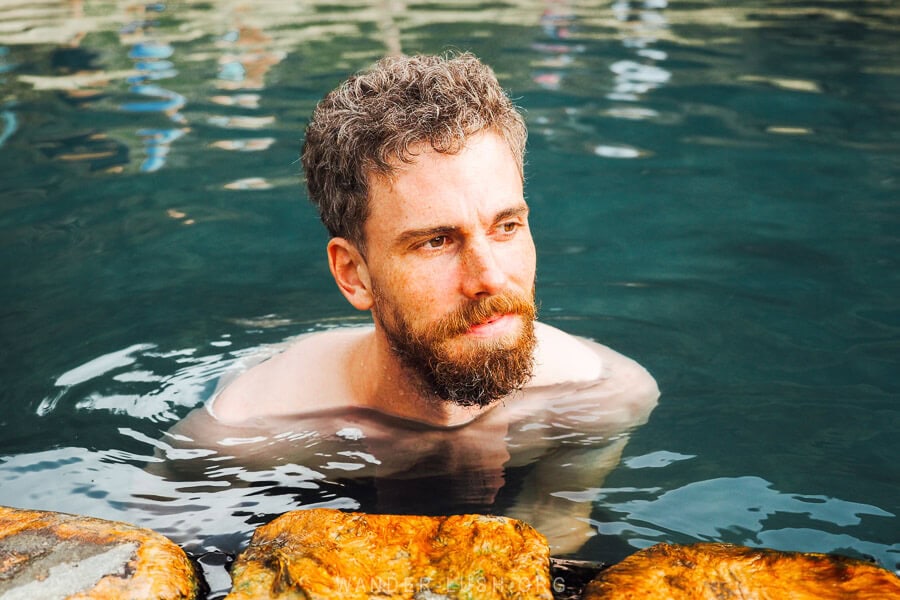
There are a few restaurants and shops around, but not much else in the way of facilities. That will probably change soon: At the time of our visit, there were cabins and booths being erected. I assume that like the Blue Eye, visitors will soon have to pay for the privilege of visiting Benja.
The pools are a 30-minute drive from Permet. If you don’t have your own car, it is easy to organise a taxi transfer from the city. There is also a public bus service to Benja from Permet, with buses departing from the main boulevard between 8am and 4pm.
4. Find the lesser-visited Sarandaporo Thermal Springs
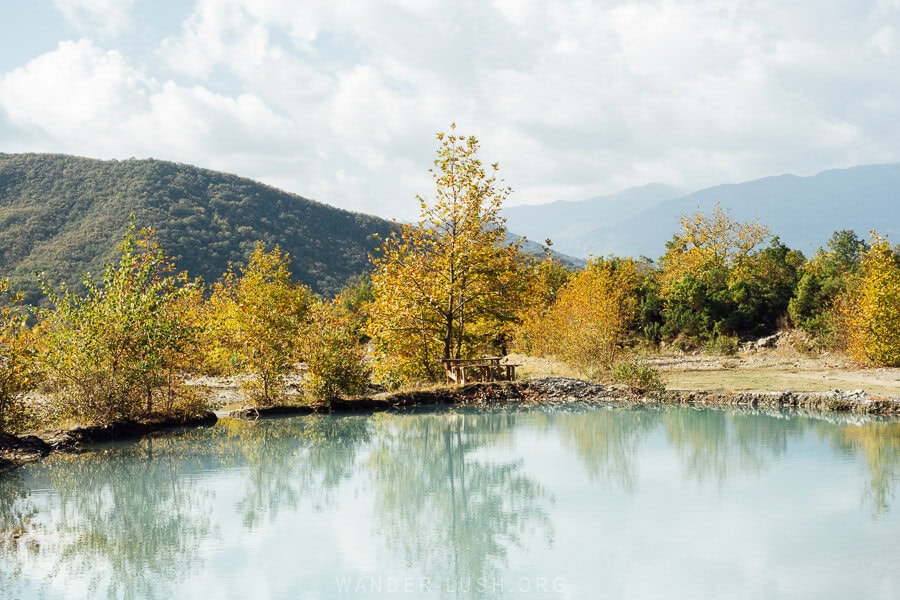
The Sarandaporo Thermal Springs are another set of curative baths, this time set on the Sarantaporos River. Technically abandoned, they see very few tourists and offer a totally different (much for adventurous) experience when compared to Benja.
We actually visited these baths from Leskovik, but you can reach them from Permet if you have your own wheels, travelling for about an hour southeast towards the Greek border. The drive follows the Vjosa and passes the viewpoint and bridge mentioned above.
The Sarantaporos River forms the natural division between Greece and Albania. There are hot and cold springs on both sides of the border. The main pools on the Albanian side are deep rectangular tubs set up on a hill overlooking the river in the shadow of an old fortress. They aren’t exactly spa-quality, but the waters are bubbling, so I assume they are clean. There are long ladders that you can use to get down – if you dare to take the plunge.
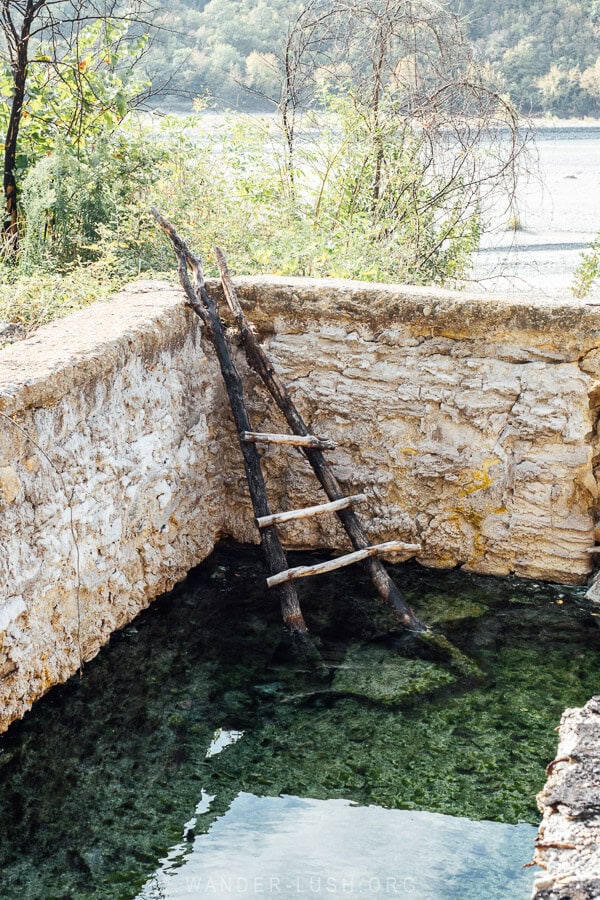
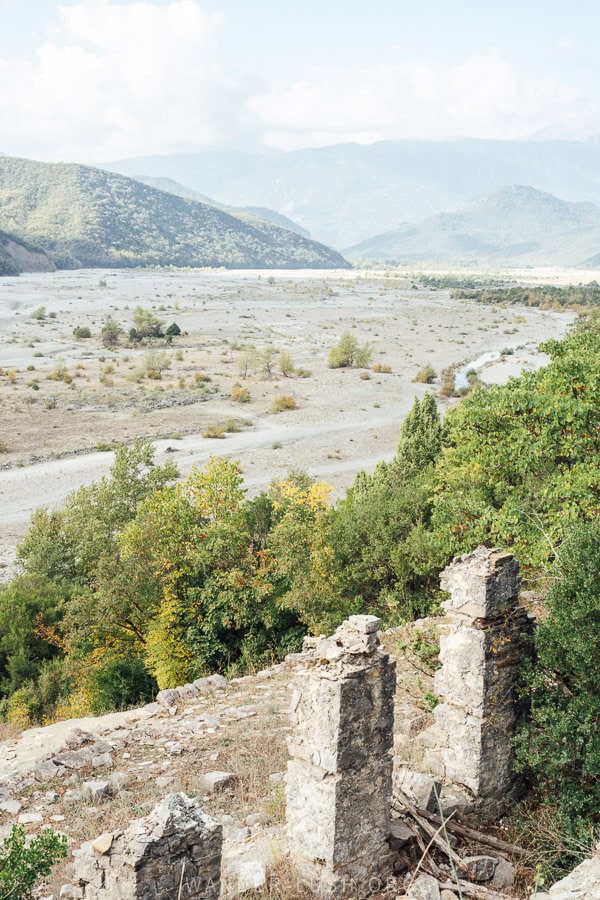
The path to the baths runs alongside the forest. You will see little fairy pools filled with milky blue water everywhere. I don’t recommend swimming in these! But they are very pretty.
There are some picnic tables scattered around plus the occasional sign board and trail marking. But overall, the area is pretty wild and you just have to follow your nose. We accidentally walked into Greece at one point… We were hunting for this sulfur cave, but the terrain was far too tricky for us to navigate.
The first part of the road down to the river’s edge is sealed. You will pass what looks like an old sanatorium hotel. You then have to drive for about 10 minutes over an unsealed track. From there, continue by foot, following the edge of the river north.
In October, the river was almost completely dry with just a few rivulets. This area could be underwater in spring and summer, I don’t know. Be very cautious if you do decide to explore, and note that there is no phone reception.
5. Go rafting on the Vjosa River
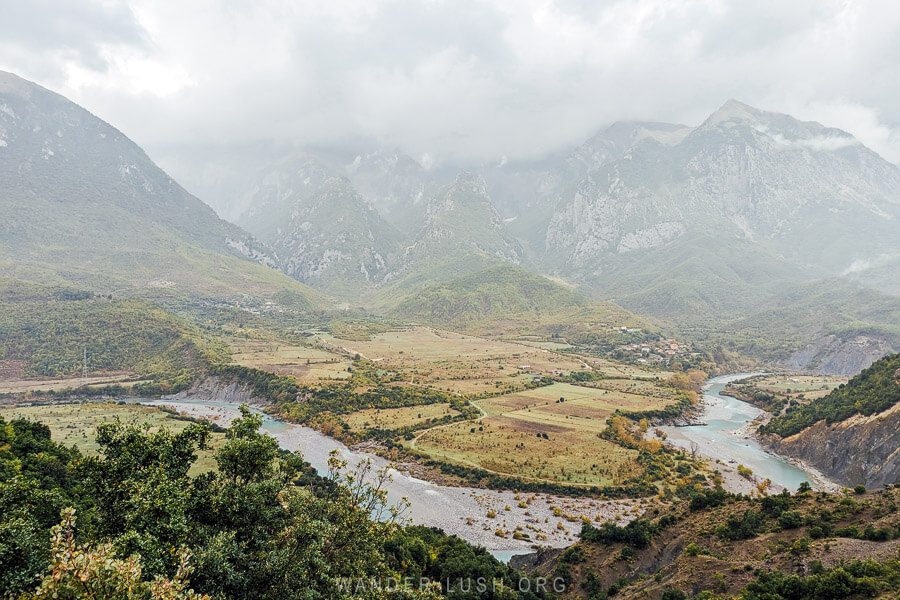
Permet is the starting point for exploring the Vjosa Wild River National Park. There is no doubt in my mind that it will become an adventure tourism hotspot in the years to come.
My biggest regret is not signing up for a rafting tour. I mistakenly assumed that the water level would be too low in October – but it appears that expeditions run for an extended season between March and December.
There are half a dozen outfits in Permet that organise rafting tours. Vjosa Albania Rafting & Kayak Camping Përmet has good reviews, and appears to be a professional operation. Trips are offered twice daily, with transfers included. The two-hour rafting experience includes stops for swimming and rock jumping.
If you prefer to stay on dry land, there are various mountain bike trails around Permet that lead to different villages and viewpoints.
For more information about rafting and biking, there is an info point outside the Hotel Alvero (also with bike hire) or you can drop into Permet’s tourist information office.
6. Explore Permet Old City
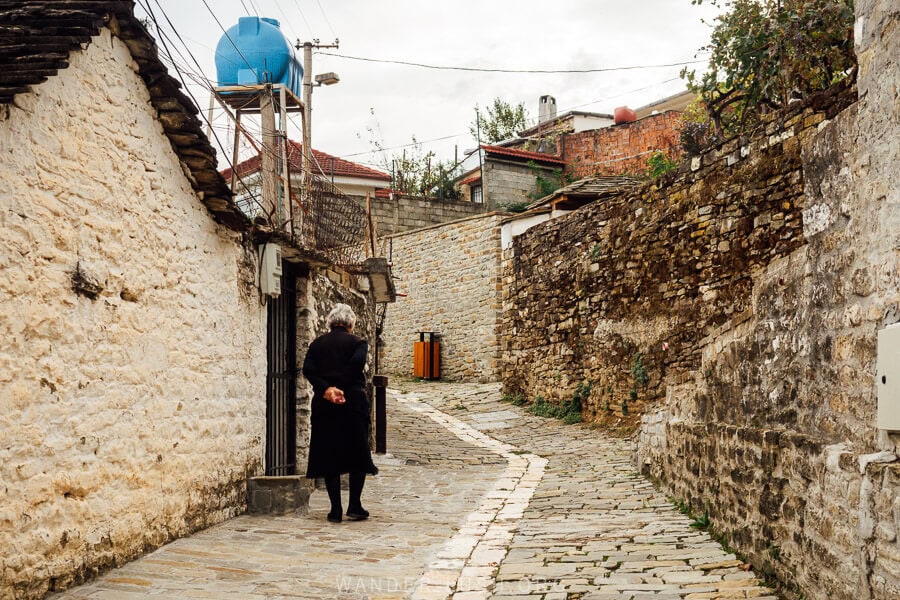
Permet itself is a small but interesting city with an eclectic mix of architecture. The centre is mostly dominated by modernist and socialist-style buildings, fading out to big concrete apartment blocks on the fringes.
The neighbourhoods of Shenkolli and Tekke on the southwestern rise are considered to be the oldest parts of Permet. It’s very pleasant to walk around this area in the evening. Villa Permet is right amongst the old streets so if you are staying here, this will be your local ‘hood.
The houses in Old Permet date to the early 19th century and were reconstructed in 2022. Grand arched gates, high stone walls and cypress trees are typical of this area, while the houses are all pieced together from local riverstone, with slabs for roof tiles.
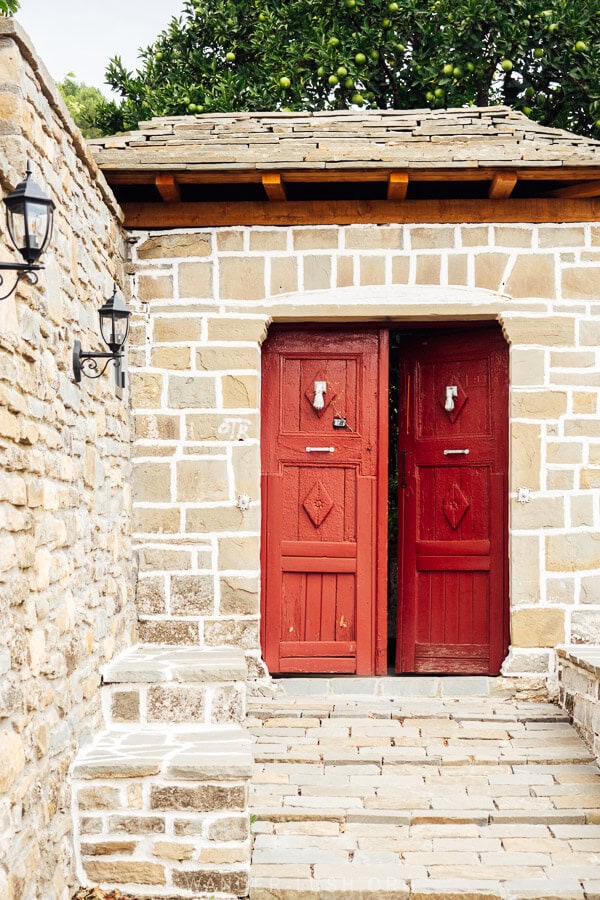
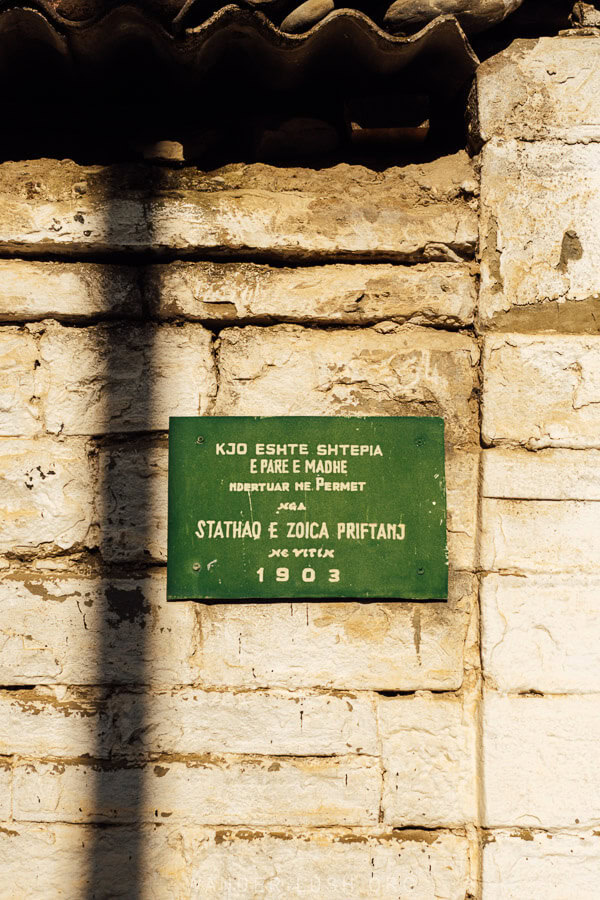
The cobbled streets, all with a valley in the centre to channel rainwater, are narrow and atmospheric. We found it helpful to follow the new lamp posts – these denote the historic streets.
On the hill above the Old City there is a Bektashi Tekke. It’s possible to walk all the way up if you wish to visit.
7. Visit the churches in Permet
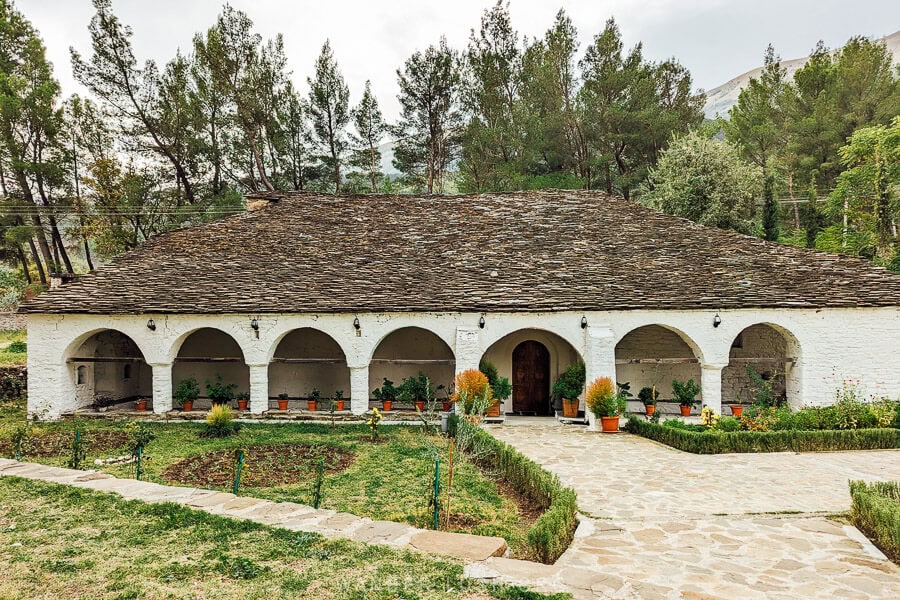
After the Church of Leus, everything else pales in comparison. Still, there are several small churches in the old part of Permet that you will no doubt pass on your travels.
The Church of St. Friday (Kisha e Shën Premtes Parashqevise) is interesting because it is so low set – its roofline is barely visible on approach. Unsurprisingly, the church has flooded several times in the past. Built of pumice stone, it dates to 1776 and is attributed to the master Ilia Christo. We unfortunately found the doors locked and couldn’t venture beyond the courtyard. But the frescoes, painted in 1808 by Terpo Zograf, son of one of the Zografi Brothers, look beautiful.
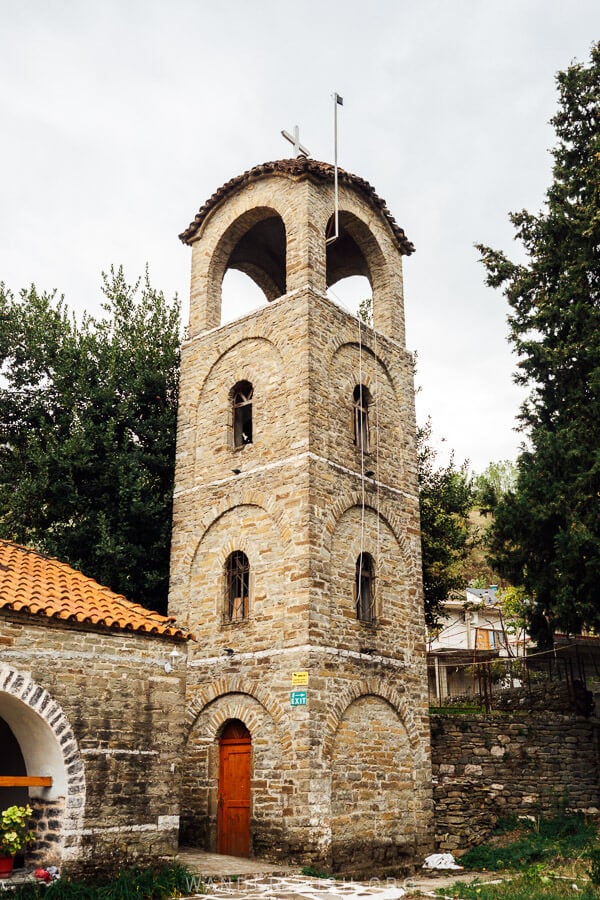
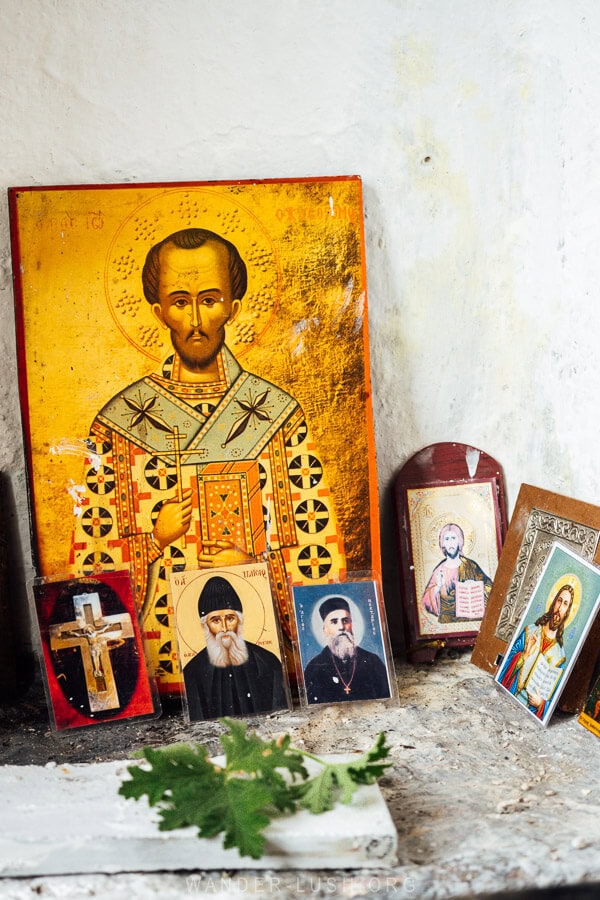
A block west, the Chruch of St. Nicholas is an older basilica that dates to 1757. It has a voluminous courtyard with a bell tower (pictured above) and precisely 7 towering cypress trees. Once again, we found the door locked.
8. Browse the antique shops
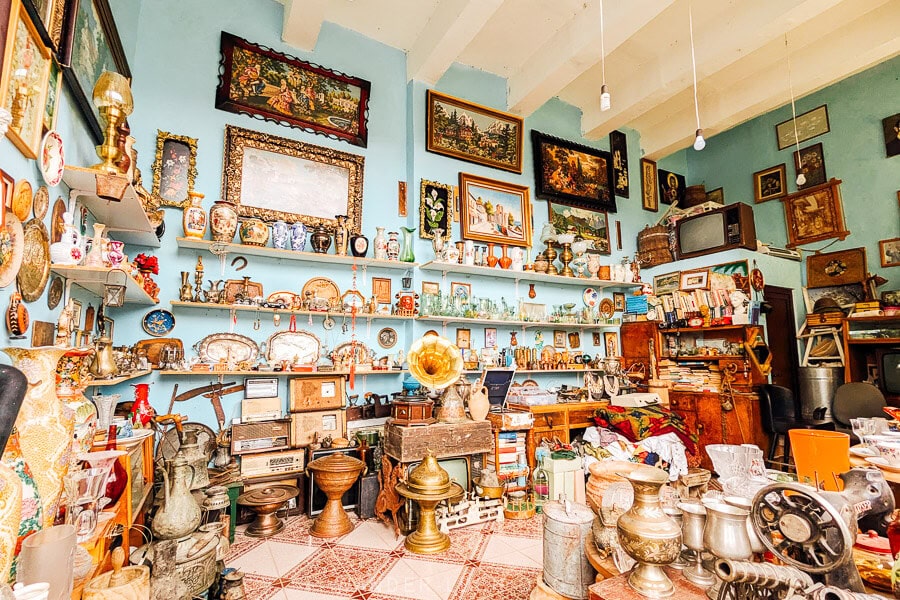
Permet has a couple of cute antique shops. The most obvious one is located between the restaurants on Mentor Xhemali. It is simply called ‘Antique Shop’.
The turquoise interior is an Instagrammer’s delight. I think the owner knows it, too – on our way out, he asked us to tag him 🙂 The shop is filled with vintage and retro objects – gramophones, silverware, ceramic vases, jewellery and various trinkets. I particularly liked the collection of Balkan wine and liquor labels.
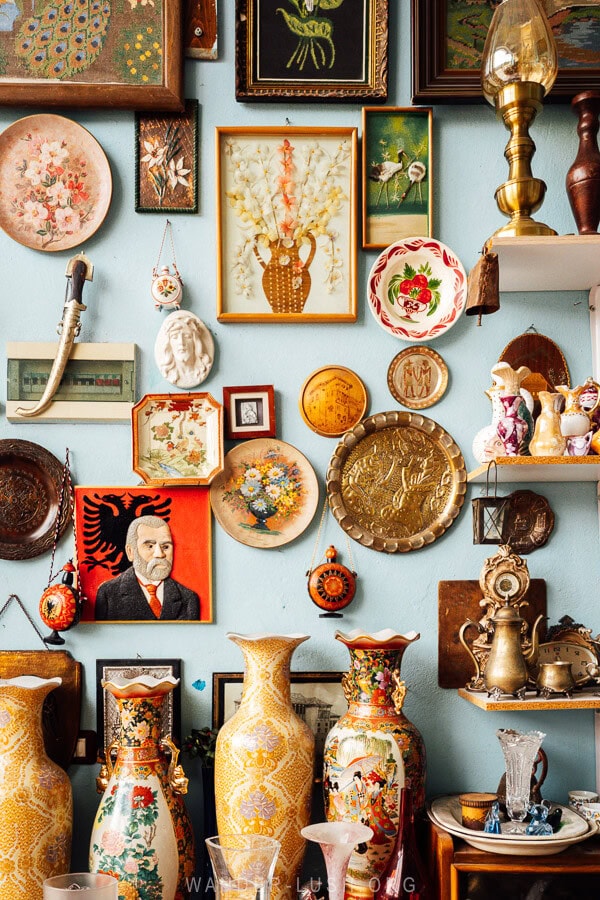
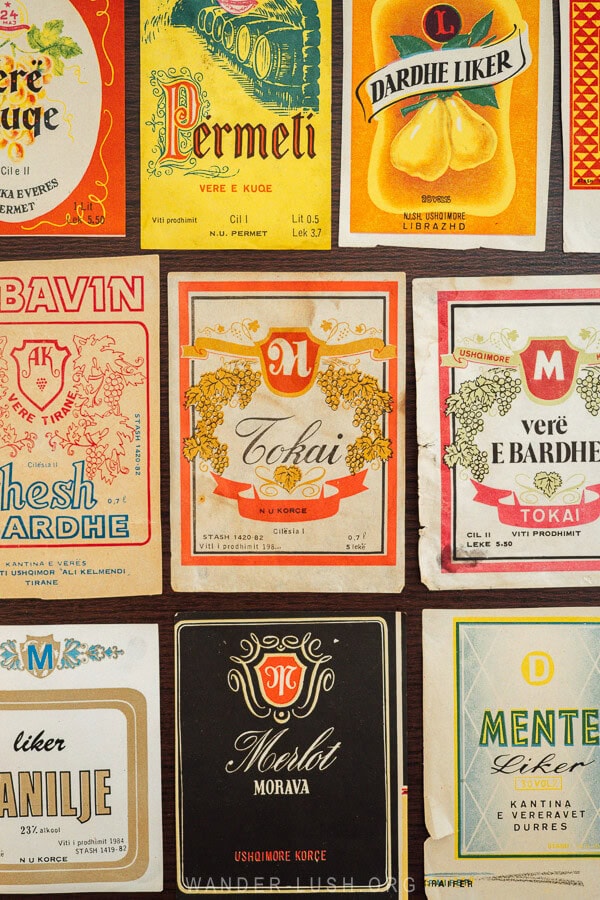
We visited a second antique shop called Kapucari ylli, which had a very nice display of old leather shoes. I forgot to pin it, but it is located on one of the nearby sidestreets. If you have the location, please let me know!
9. Summit Guri i Qytetit, Permet’s city stone
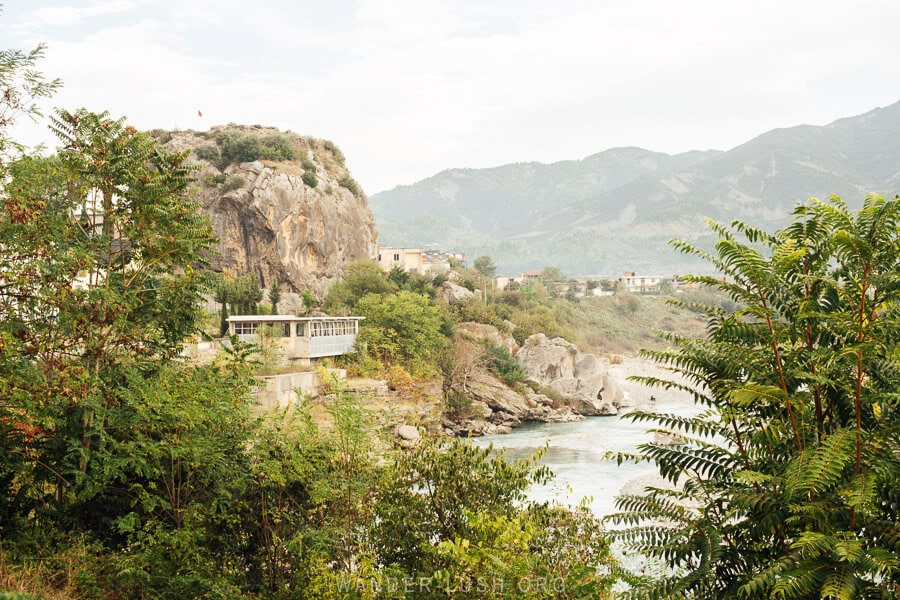
Guri i Qytetit (‘City Stone’) is the symbol of Permet. It is quite literally a giant 15-by-25-metre boulder dropped by magic in the middle of the city.
A set of metal stairs embedded on the northern face allow visitors to summit the stone for a 360-degree view of the city and the Vjosa River. The staircase is easy to manage and accessible 24-7, making this a nice spot for sunrise or sunset.
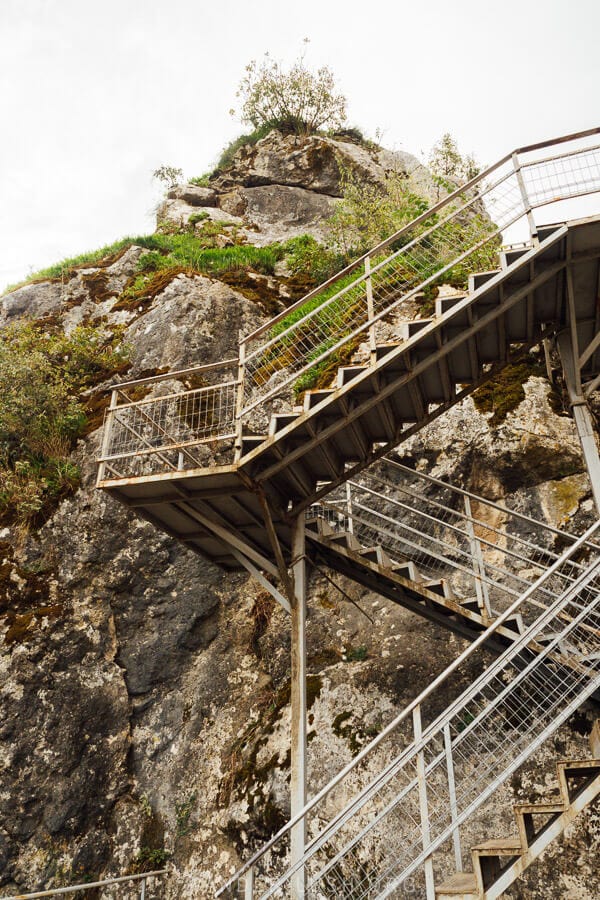
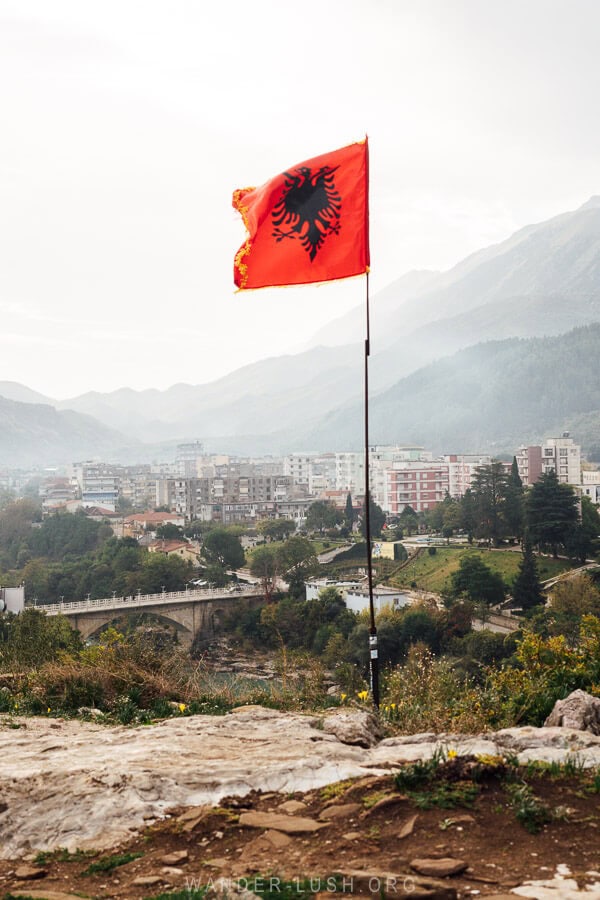
Guri i Qytetit is tied to a local legend. In 1417, when Permet was invaded by the Ottomans, it’s said that the local ruler went down with the ship as it were by throwing himself (and his daughter) off the top of the rock. His name, Premt, was given to the city.
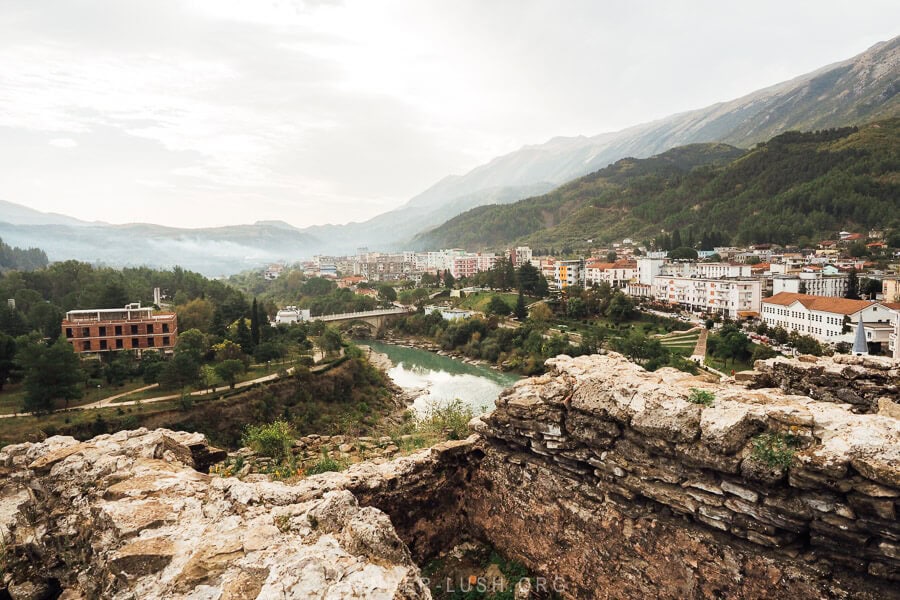
On the top of the rock you will see fragments of stone wall – the outlines of a watchtower and fortress from the Middle Ages. To the east, you can look out over the river and city, the spire of the nearby Permet Mosque in the foreground.
The Palace of Sports building – a classic piece of communist-style architecture with a zig-zag roofline – sits at the foot of the rock and nearby, there is a lone concrete bunker.
10. Walk the Vjosa promenade & cross the bridge to the War Memorial

Starting from Guri i Qytetit, walk south along the Vjosa via the lovely new pedestrian promenade that hugs the riverline. En route, there are a few little parks, sculptures and viewing platforms that jut out over the river’s edge.
When you reach the bridge, use the stairs on the Bucelat to walk up to Permet’s Central Park. We took a stroll here one evening – the older folks gathered on park benches took a keen interest in us. Everyone was very sweet.
After crossing the bridge, you can walk down to the river’s edge for a different perspective on the city and the stone. There are a few little river beaches here that are apparently popular swimming spots.
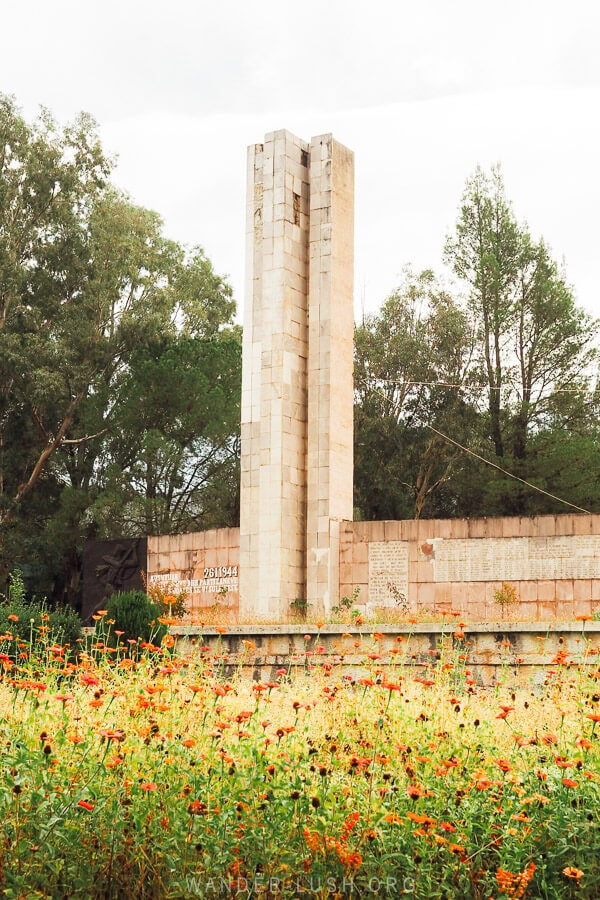
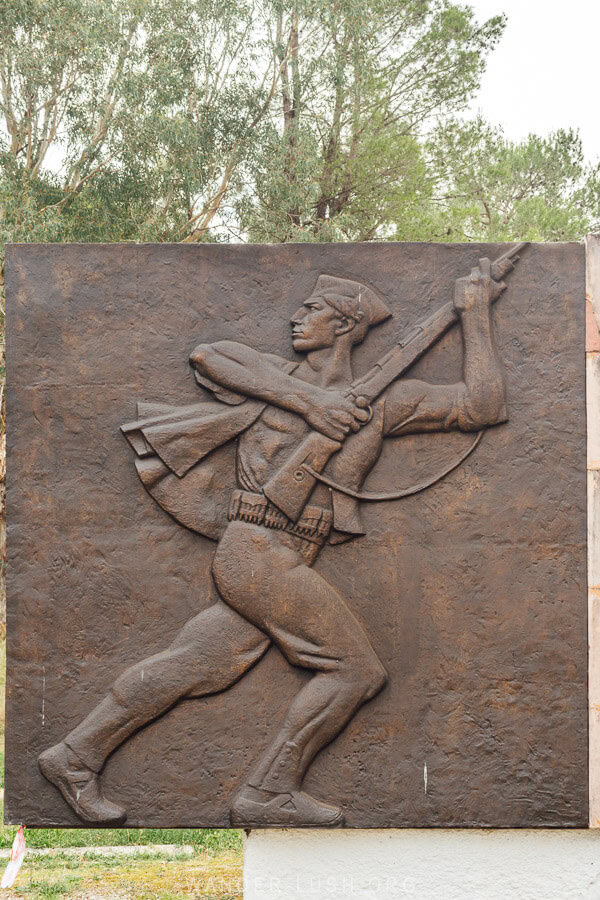
There is not much to see on the opposite side of the river. We continued on to the WWII Memorial, which is dedicated specifically to the partisan offensive of November 1944.
11. Go for a xhiro on Mentor Xhemali Boulevard
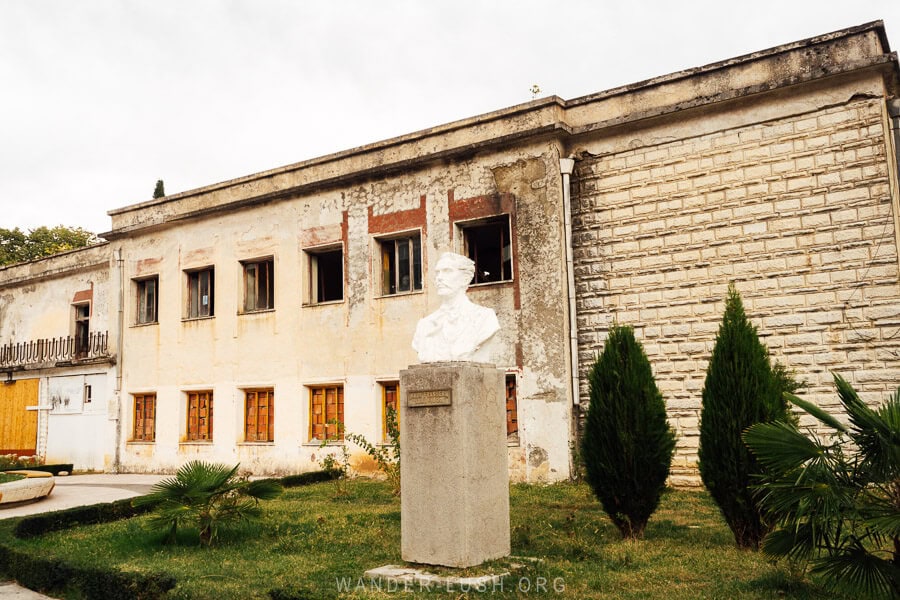
Mentor Xhemali Boulevard is Permet’s main thoroughfare. The section alongside Central Park is closed to traffic on Friday and Saturday evenings, when it transforms into a lively pedestrian promenade as people emerge for their nightly xhiro.
Xhiro is an Albanian tradition where people stroll, enjoy an ice cream or sip an espresso whilst socialising with their neighbours. I always like to observe or participate in this wherever I am in Albania – it’s always fun.
There are several sidewalk cafes where you can settle down with a coffee and people-watch. Be sure to read the Google Reviews before you decide on a cafe, and ask for the menu upfront. We went to a little place next door to Book House and enjoyed a couple of cappuccinos for 150 lek each.
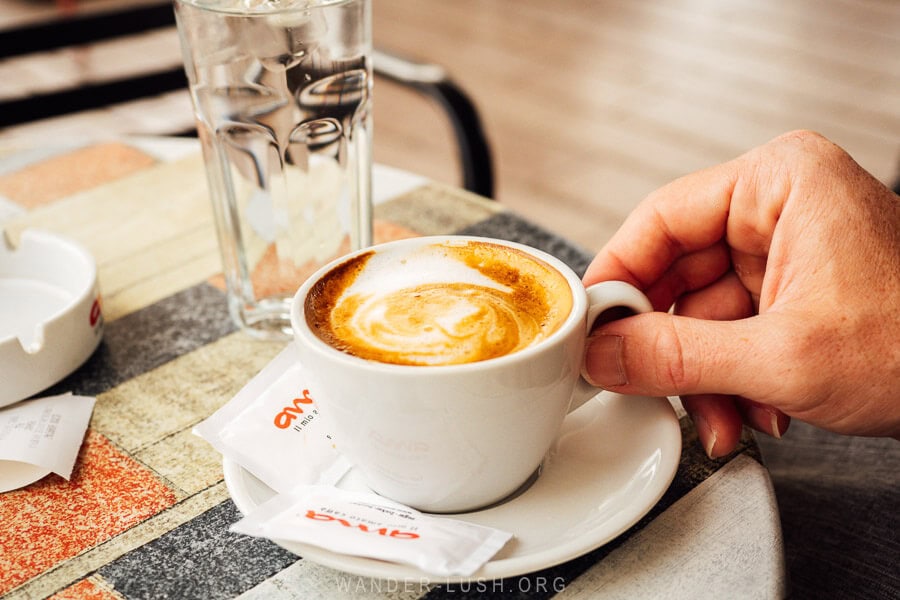
Opposite is the Nativity of Mother of God, a makeshift chapel inside a rundown building. At the time of our visit it was under construction – I saw the priest himself lugging lumber.
12. See the original Permet Congress statue
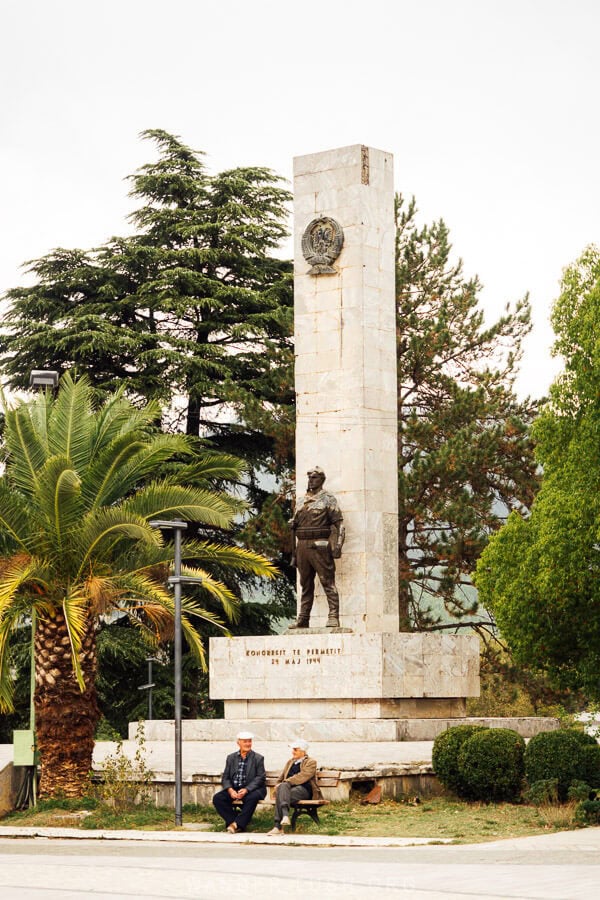
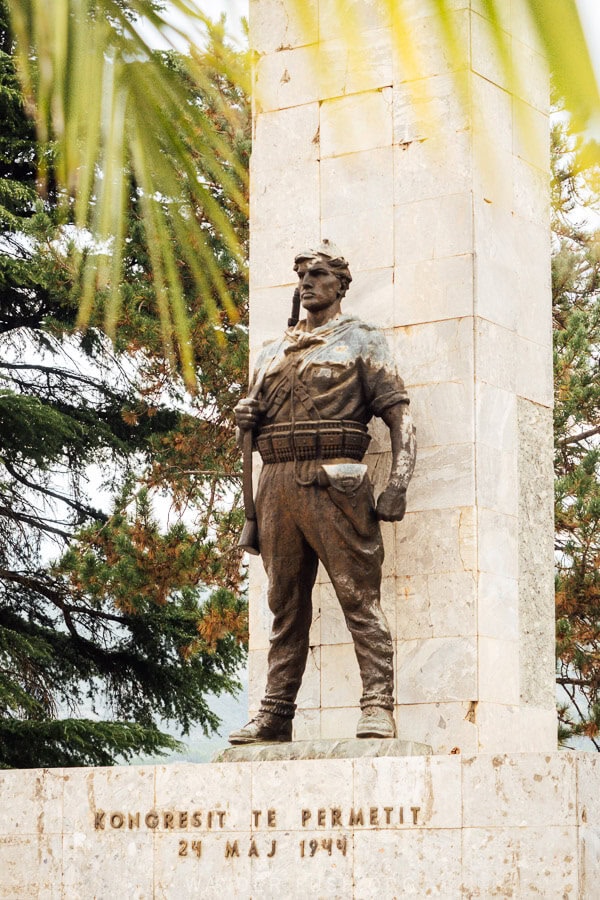
Located at the top of the boulevard, this statue pays tribute to the Congress of Permet (Kongresit të Përmetit), when communist leaders met in Permet on May 24, 1944 to elect a Provisional Government. In Albanian history this is considered a pivotal moment for anti-fascism and national liberation.
If you have been to Gjirokaster, you would have seen a replica of the soldier statue at the entrance to the castle. The one in Permet is the original.
Where to go next: More ideas for Albania
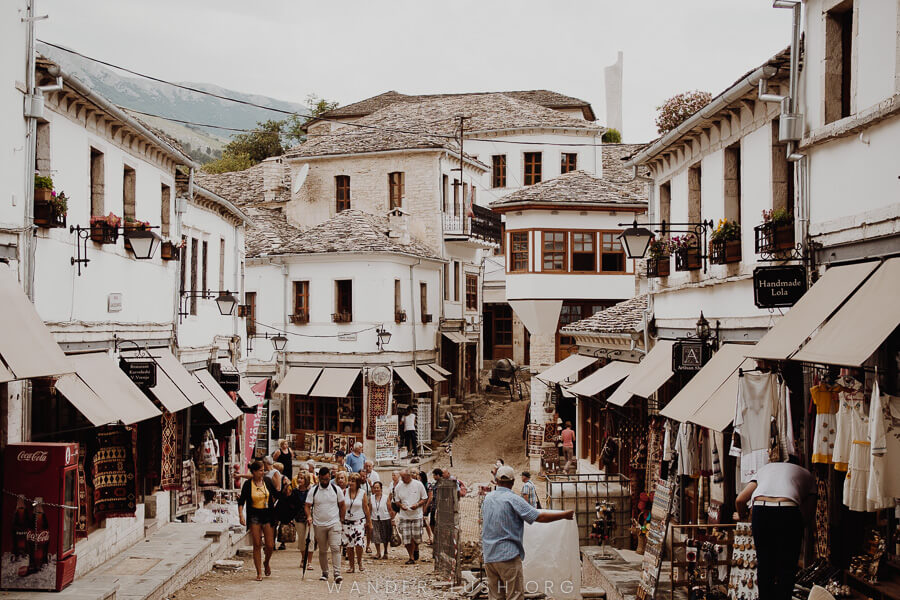
Albania Travel Guide
Discover insider tips, itinerary inspiration, and all the best things to see, do and experience in Albania!
Albania Essentials
My favourite resources and tools for planning a trip to Albania.
More from Albania
Albania Travel Guide
Discover insider tips, itinerary inspiration, and all the best things to see, do and experience in Albania!



